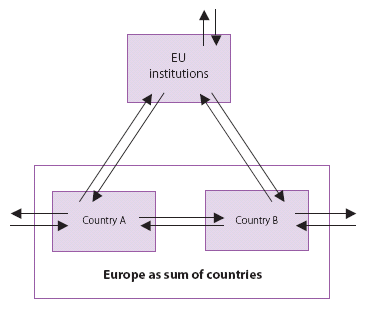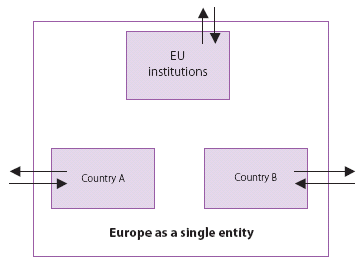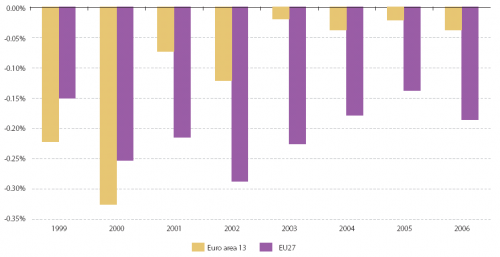European sector accounts - background
The sector accounts are the part of the national accounts that records the economic flows and stocks of the institutional agents classified in “sectors” according to their economic behaviour and function in the economy.
They are necessary to answer questions such as: are households spending or saving a bigger share of their income? Are corporations investing more or do they prefer to retain their earnings? Is the economy financing its investments through its total savings or is it borrowing from abroad?
Among sector accounts, one generally distinguishes between the non-financial accounts, the financial accounts and the balance sheets. Non-financial sector accounts record flows according to their economic nature, such as output, wages, taxes, subsidies etc. The financial accounts record flows by financial instrument (e.g. currency, loans, shares etc.). The balance sheets record the stocks of non-financial assets (e.g. building, machinery) and financial assets and liabilities (e.g. currency, loans, shares, etc.)
The annual sector accounts of the Member States of the European Union (EU) have been compiled according to one common methodology described in the European System of Accounts 2010 (ESA 2010), which superseded European System of Accounts 1995 (ESA95).
With the start of the euro area, it was felt necessary to supplement national sector accounts as provided by the Member States with genuine European sector accounts that would reflect the economic situation of the euro area / European Union as a whole. In order to “consolidate” the accounts of the Member States across borders, Eurostat and the European Central Bank worked out a special methodology, in close cooperation with the national statistical institutes and national central banks.
This article provides methodological information on the compilation of European non-financial sector accounts. Section II outlines the basic features of sector accounts. Section III describes the methods used for the compilation of European aggregates.
Full article
Sector accounts
The European sector accounts aim to provide a comprehensive and comparable overview of the European economy as a whole. They record all “transactions” between economic agents grouped by “sector”. The system forms a sequence of interlinked accounts.
Institutional sectors
The institutional sectors bring together economic agents with broadly similar behaviour: non-financial corporations, financial corporations, general government and households. Transactions between domestic economic agents and economic players residing abroad are recorded in the “rest of the world” accounts.
The sector accounts thus show the interactions between the different sectors of a given economy, and between them and the rest of the world.
Transactions
Transactions are classified according to their economic nature (e.g. payment and receipt of wages or taxes, consumption, granting of a loan, etc.).
They belong to two main categories: transactions in goods and services and distributive transactions.
- Transactions in goods and services
All flows related to the supply and use of goods and services during the period considered are recorded as transactions in goods and services.
The supply of goods and services provided by each producing sector of the economy is recorded as “output”. Goods and services bought abroad are recorded as “imports” in the Rest of the World accounts.
The different uses of goods and services in the domestic economy are: “intermediate consumption”, “final consumption” and “gross capital formation” depending on their role in the economic process. “Intermediate consumption” is the value of goods and services consumed as inputs by a production process; “final consumption” stands for the goods and services used for satisfaction of individual needs (by households) or of collective needs (by general government); “gross capital formation” means investment in fixed assets (e.g. buildings, machinery, private dwellings, agricultural livestock, and intangible assets) and changes in inventories. Goods and services sold abroad are recorded as “exports” in the Rest of the World accounts.
For goods and services as a whole, total supply should equal total use, which leads to the following equation:
Or:
Where GDP stands for gross domestic product and measures the value of goods and services produced during the period considered.
- Distributive transactions
Distributive transactions consist of economic flows that involve the (re-)distribution of income created by the production of goods and services.
For each distributive transaction, the amounts that are paid by a sector are recorded as “uses” whereas the amounts received are recorded as “resources”. For instance, the “uses” side of the transaction category “compensation of employees” records the amounts of wages and salaries and social contributions payable by all the country’s employers, namely non-financial corporations, financial corporations, government and households (as individual entrepreneurs), and employers residing abroad (rest of the world sector).
The resources side shows the compensation of employees receivable by the relevant sectors of the economy, namely:
- the household sector with respect to the households that reside in the country considered;
- the rest of the world sector for households that are paid in the country considered but reside abroad.
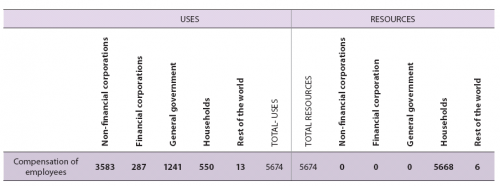
As shown in Table 1, for each type of distributive transaction, total resources of all sectors and the rest of the world accounts equal total use. On the use side, two thirds of the total amount of compensation of employees is paid by non-financial corporations. The other third is paid either by general government, households (as individual entrepreneurs), financial corporations or non-residents (rest of the world sector). On the resources side, almost all compensation of employees is received by resident households.
Sequence of accounts
Transactions are grouped into a sequence of accounts covering a specific aspect of the economic process, ranging from production, generation and (re)distribution of income through consumption and investment to borrowing and lending. Each account is closed by a balancing item defined as total resources minus total use, and this is carried over to the next account.
Some balancing items are of great analytical interest, for example gross operating surplus, disposable income and saving. The final balancing item of the non-financial sector accounts is net lending/borrowing, which is equal to all flows received minus all flows paid by each institutional sector. It then reflects whether a given sector has increased/decreased its financial wealth through economic activities carried out during the period considered.
European sector accounts
The euro area/European Union accounts are based on, but are not the simple sum of, the national accounts of the Member States. First, the accounts of European institutions and bodies need to be added. Second, cross-border transactions between European countries have to be eliminated from the rest of the world accounts. Third, imbalances which are mainly caused by the removal of intra-flows, called “asymmetries”, are eliminated in order to re-balance the accounts.
In the diagram below, these transformations are presented using a simple example, assuming that Europe is made up of two countries, A and B. All economic flows are displayed with arrows.
In the first diagram, the European Union accounts are compiled as the mere sum of the national accounts of countries A and B. Both intra-flows between countries A and B and flows vis-à-vis third countries are taken into account. The EU institutions are not part of the European aggregate.
In this second diagram, the European Union is considered as a single entity. Only flows vis-à-vis third countries are taken into account. The EU institutions are included in the European aggregate.
Since 2006, European sector accounts at current prices have been compiled according to the single-entity principle. The other European aggregates, in particular volume data, are still compiled using the first approach.
The main steps in the compilation of European sector accounts are detailed below.
European Union institutions and other European bodies
The European Union institutions and other European bodies are not considered to be part of the domestic economy in the national accounts compiled by the Member States. Consequently, the sector accounts provided by the Member States do not record the activities of institutions and bodies set up by European treaties as resident entities. By contrast, the European institutions are part of the domestic sectors of the European Union economy (not the euro area).
With the exceptions of the European Central Bank and the European Investment Bank (EIB), which are both classified in the financial corporations sector, all European institutions are classified in the government sector.
For the general government sector, the EUI are the following:
- The Council
- The European Commission
- The European Parliament
- The European Court of Justice
- The European Court of Auditors
- The Social and Economic Committee
- The Committee of the Regions
- European agencies whose accounts are part of the general budget of the European Union
Significant transactions, especially transfers, take place between the above institutions and Member States. This is particularly the case for the Commission, which administers European policies that involve financial transfers.
European institutions are not included in the euro area accounts because their administrative competence goes beyond the boundaries of the monetary union. The ECB is the only institution included in the financial corporations sector in both the euro area and the European Union accounts.
The rest of the world in the European accounts
The rest of the world accounts, as compiled by the Member States, record transactions between the national economies and all non-resident units, including those in other European Member States. For instance, imports/exports recorded in Member States’ national accounts include the goods and services bought from or sold abroad, whether from or to a resident of the euro area, of the European Union or of a third country.
To reflect appropriately the transactions between European areas and third countries, it is therefore necessary to remove, from the sum of national rest of the world sectors, the economic flows within the area considered (“intra-European flows”).
There is insufficient data on the rest of the world sector breakdown into intra/extra euro area/European Union in the national accounts data sets. Consequently, the European accounts draw on both the national and the European balance of payments statistics. In other words, the “intra flows” are estimated using the geographical breakdown provided by balance of payments (BoP) data.
Note that, because of different data revision policies and conceptual differences, it is not possible to ensure full consistency between the European rest of the world sector and BoP statistics at this stage.
Moreover, for “intra flows”, total resources should theoretically equal total uses. For instance, within the euro area, total “intra”-imports should equal total “intra”-exports. However, this is not the case in practice. The comparison of total intraflows in resources and uses reveals imbalances called “asymmetries”.
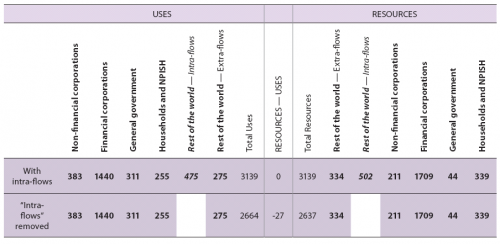
As a consequence, European accounts cannot be derived by simply removing the intra-flows of each transaction. The resulting discrepancies have to be allocated to the various resident sectors in order to re-balance the European accounts. Table 2 illustrates the removal of the “intra” European flows using interest flows as an example.
In the case of the European Union, about two thirds of the cross-border flows of interest are paid to or received from other countries of the European Union. For example, on the use side of the Rest of the World accounts, EUR 475 (out of 750) billion has been removed as “intra-European” flows of interest.
Balancing the European accounts
As illustrated in the example above, removing the intra-flows from the European Rest of the World accounts creates imbalances between total resources and total uses when conceptually they should be equal.
In the case of transactions in goods and services, these imbalances are created by the difference between intra-imports and intra-exports called “asymmetries”.
Goods and Services
Asymmetries in goods and services are, in absolute terms, the most important discrepancies in the European sector accounts. In 2006, they reached EUR 46 billion for the euro area and EUR 124 billion for the European Union. These amounts represent respectively 0.3% and 0.5% of the total supply of goods and services for the areas concerned. These asymmetries have to be allocated to the different transactions in goods and services so that total supply and total uses remain balanced in the European accounts [see equation 1) above].
To allocate asymmetries in goods, intra-community trade statistics collected under the Intrastat regulation[1] are used. These data provide a breakdown of intra-flows of goods by final use categories. These proportions are used to allocate asymmetries in goods to the intermediate consumption and gross fixed capital formation (“investment”) of households and non-financial corporations.
Asymmetries in services are allocated to the intermediate consumption of non-financial corporations and to the final consumption of households on a pro rata basis. This balancing process has an impact on goods and services transactions, and therefore on the level of the Gross Domestic Product of the areas concerned. As illustrated in Figure 1, the GDP of the European Union is about 0.2% lower after balancing. In the euro area case, balancing caused a decrease of about 0.3% in the beginning of the period (1999 and 2000) whereas the impact decreased significantly in the recent years (-0.04 % in 2006).
Distributive transactions
Total resources must also equal total uses for each distributive transaction, when summed over all institutional sectors and the rest of the world. For example, total interest revenue of all sectors and the rest of the world combined must be equal to total interest expenditure.
For distributive transactions as well, the removal of “intra” European flows creates imbalances as illustrated in Table 2 in the case of interest.
In order to balance distributive transactions, the method consists of identifying the items to which the discrepancies should be allocated.
In practice, the following rules are applied:
- For each transaction, discrepancies are allocated to the sectors whose data are deemed less reliable according to experts’ judgment;
- government data, which are considered more reliable, are not affected by the balancing procedure;
- rest of the world data are not affected by the balancing procedure either except where they conflict with government data (e.g. in the case of taxes and subsidies on products).
For compensation of employees, the discrepancy is totally allocated to the amounts received by the households sector. Indeed, in most Member States, this item is indirectly estimated as the sum of the compensation of employees paid by all other sectors. It is also the most important item for this transaction so that the impact of balancing is minimised.
The same kind of reasoning is applied to other transactions which are more or less directly related to salaries, i.e. social contributions, social benefits and the adjustment for the change in net equity of households in pension funds reserves.
In the case of interest, imbalances (total resources minus total use) are allocated on a pro rata basis as illustrated in Table 3 (follow-up of Table 2).
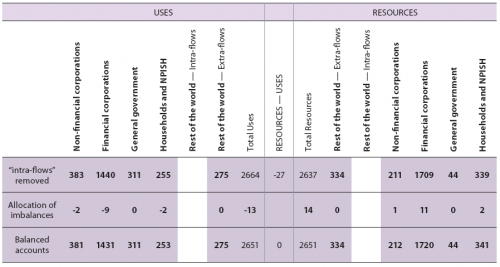
As was shown in Table 2, removing intra-European flows creates an imbalance of EUR -27 billion between total interest received and total interest paid. This imbalance between resources and use of interest has been distributed among the resident sectors except general government as shown in Table 3. For example, the amounts recorded for the interest received by financial corporations were EUR 1709 billion before adjustment and EUR 1720 billion afterwards.
The same method is used for the other transactions related to property income and other current transfers, as there is no obvious single absorbing item. Consequently, imbalances are allocated to the domestic sectors (other than government) on a pro-rata basis.
For the transactions “net non-life insurance premiums” and “current taxes on income and wealth”, the discrepancy is proportionally allocated among the domestic sectors (other than government) on the use side. For the transaction “nonlife insurance claims”, it is the opposite: the discrepancy is allocated among the non-government domestic sectors on the resources side.
For taxes and subsidies on products, as government data are considered more reliable and should not be affected by the balancing method, the adjustment falls on the rest of the world accounts. As regards other taxes and subsidies on production, the discrepancy is totally allocated to the non-financial corporations that represent by far the biggest amount for taxes paid and subsidies received.
For capital taxes, the most important taxpayer, namely the households sector, was chosen to absorb the discrepancy. As regards the other capital transfers, the imbalance was allocated between the amount received by non-financial corporations and households.
Conclusion
With the start of the euro area and the successive enlargements of the European Union, new user needs have emerged for genuine European accounts.
In order to compile such accounts, it was necessary to include European institutions and consolidate cross-border flows within the areas considered. The removal of intra-flows has led to discrepancies between resources and uses that have been resolved by balancing the accounts, thus impacting on aggregates like the European GDP at current prices.
The result of the whole compilation process, from the individual country data to the final balancing procedure, gives a balanced and consistent set of sector accounts for the euro area and the European Union.
The European sector accounts are no longer the sum of national accounts transmitted by the Member States. They are also different from other euro area/European Union national accounts publications, in which cross-border flows within the area concerned have not yet been removed.
The methodology broadly described above has been used to compile the European sector accounts that were published for the first time in 2006 (annual accounts) and in 2007 (quarterly accounts). These data are available, together with methodological information in English, French and German, on the European sector accounts dedicated section on the Eurostat web site.
Direct access to
Notes
- ↑ Statistics relating to the trading of goods by the EU and its Member States with non-member countries are based on Regulation (EC) No 1172/95 and Regulation (EC) No 1917/2000.
